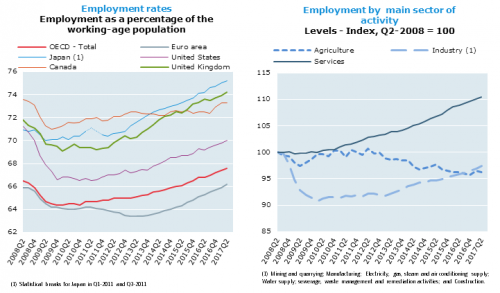OECD employment rate increases to 67.6% in the second quarter of 2017
The OECD area employment rate – defined as the share of people of working-age in employment – increased by 0.2 percentage point in the second quarter of 2017, to 67.6%; 3.2 percentage points above the 2009 low and 1.0 percentage point above the previous peak in 2008. Around 559 million persons were employed in the second quarter of 2017, 26 million more than in the second quarter of 2008.

Compared to the first quarter of 2017, the euro area employment rate rose by 0.3 percentage point (to 66.2%), with the highest quarterly increases observed in Greece (up 0.8 percentage point, to 53.6%), Portugal (up 0.6 percentage point, to 67.3%), Spain (up 0.6 percentage point, to 61.0%) and Slovenia (up 0.5 percentage point, to 68.7%); by contrast, the employment rate fell by 0.7 percentage point, to 73.0%, in Estonia.
Employment rates also increased in the United Kingdom (by 0.3 percentage point, to 74.2%), Japan (by 0.2 percentage point, to 75.2%), the United States (by 0.2 percentage point, to 70.0%), and marginally in Korea (to 66.6%). Employment rates were stable in Canada (at 73.3%) and Turkey (at 50.9%) but decreased by 0.3 percentage point in Mexico (to 61.1%) and by 0.5 percentage point in New Zealand (to 76.2%).
The higher OECD area employment level since the second quarter of 2008 reflects employment gains in services as employment still remains below pre-crisis levels in industry and in agriculture. As a result, the service sector's share (73.3%) of OECD employment was 2.6 percentage points higher than in the second quarter of 2008, while that for agriculture (4.6%) and industry (22.1%) were, respectively, 0.4 and 2.1 percentage points lower. The decrease in the share of employment in industry was especially pronounced in southern European countries, with declines of 4.0 percentage points or more in Greece, Italy, Spain and Portugal.
Source: Organization for Economic Co-operation and Development
- 351 reads
Human Rights
Fostering a More Humane World: The 28th Eurasian Economic Summi

Conscience, Hope, and Action: Keys to Global Peace and Sustainability

Ringing FOWPAL’s Peace Bell for the World:Nobel Peace Prize Laureates’ Visions and Actions

Protecting the World’s Cultural Diversity for a Sustainable Future

Puppet Show I International Friendship Day 2020

